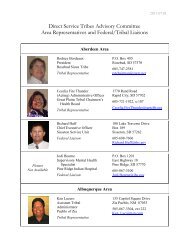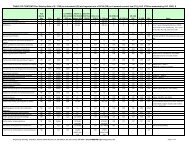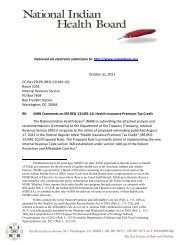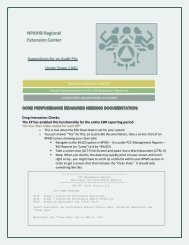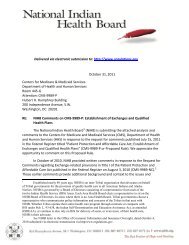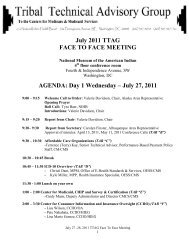mmpc - National Indian Health Board
mmpc - National Indian Health Board
mmpc - National Indian Health Board
Create successful ePaper yourself
Turn your PDF publications into a flip-book with our unique Google optimized e-Paper software.
<strong>Indian</strong> eligibility determinations, with the identification of specific exceptions to these rules when<br />
necessary for any of the <strong>Indian</strong>-specific protections and benefits.<br />
II. Focus of This Paper<br />
v.7, 2012‐09‐23a<br />
This paper is intended to address two core issues of concern. First, the reliance on three different sections<br />
of federal law to define “<strong>Indian</strong>” under the Affordable Care Act has created confusion as to how an<br />
Exchange will implement the definitions for the different ACA protections and benefits that they apply.<br />
(Ironically, because the three definitions are actually nearly identical, the definitions themselves do not<br />
create this confusion.) Second, the Center for Consumer Information and Insurance Oversight<br />
(CMS/CCIIO), an agency within CMS with primary responsibility for ACA implementation, and the<br />
Internal Revenue Service (IRS) need to utilize the knowledge and experience of agencies responsible for<br />
implementing eligibility for <strong>Indian</strong>-specific health benefits prior to enactment of the ACA. The CMS<br />
Center for Medicaid and State Operations (CMS/CMSO), which is responsible for Medicaid operations<br />
including <strong>Indian</strong>-specific Medicaid protections, have developed regulations and materials to provide the<br />
operational guidance to determine who is a “member of an <strong>Indian</strong> tribe” (which is the core element under<br />
each definition of <strong>Indian</strong>) . An Exchange 14 will ultimately learn – as did CMS/CMSO – that they need<br />
detailed guidance materials to assist Federal, Tribal and State officials in determining that a person falls<br />
within the statutory definition of <strong>Indian</strong>. 15<br />
If implementation guidance is not rooted in the CMS/CMSO’s Medicaid experiences, or if no<br />
implementation guidance is provided beyond the definition itself, the results for American <strong>Indian</strong>s and<br />
Alaska Natives are very likely to be a significant number of AI/ANs not gaining access to the benefits and<br />
protections for which they are eligible, as well as disruptions to an otherwise streamlined eligibility<br />
determination and enrollment process. For an Exchange, the results would likely be greater costs and<br />
longer processing times, as well as a heightened error rate among the Exchange staff and outside assisters.<br />
Each of these results would run counter to the expressed goals of the Affordable Care Act. 16<br />
This paper presents options for avoiding these potentially detrimental results when determining eligibility<br />
for <strong>Indian</strong>-specific benefits and protections through an Exchange. We believe the options presented are<br />
within the authority of an Exchange to implement, whether a state-based or Federally-facilitated<br />
Exchange.<br />
III. Background<br />
After a great deal of interaction with tribes, in March of 2012 CMS issued guidance that the two<br />
definitions of <strong>Indian</strong> that apply to Exchange-related protections are “operationally the same.” 17 This<br />
should largely mitigate the confusion generated from having to apply two different sections of federal law<br />
to determine who is eligible for the two <strong>Indian</strong>-specific protections available through an Exchange.<br />
Under each definition, the core criterion is that an <strong>Indian</strong> is “a member of an <strong>Indian</strong> tribe.”<br />
There is general acceptance that all tribes listed by the Bureau of <strong>Indian</strong> Affairs as Federally-recognized<br />
tribes are included in the definition of <strong>Indian</strong> tribe. But this is not the sole determination of which entities<br />
are included under “<strong>Indian</strong> tribe”, as that term is used in each of the statutory provisions cited in the ACA.<br />
In fact, the plain language of these definitions includes no reference to Federally-recognized Tribes.<br />
Instead, the three ACA-cited definitions include a list of entities – in fact the same list with the exception<br />
of the words “pueblo” and “group” not being included in all of the definitions – which includes<br />
Northwest Portland Area <strong>Indian</strong> <strong>Health</strong> <strong>Board</strong> Page 2 of 16




